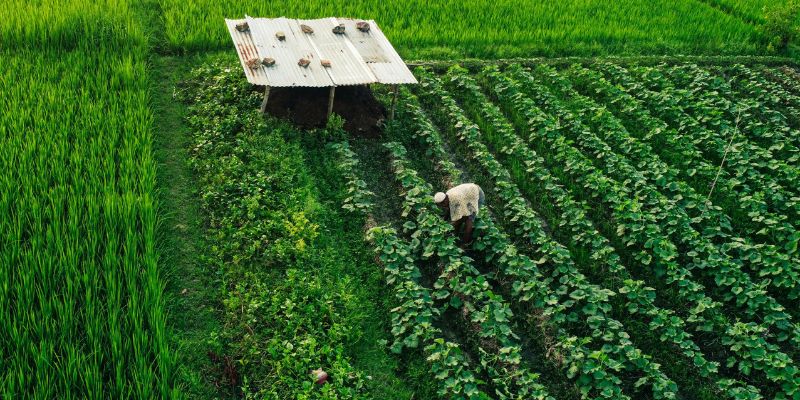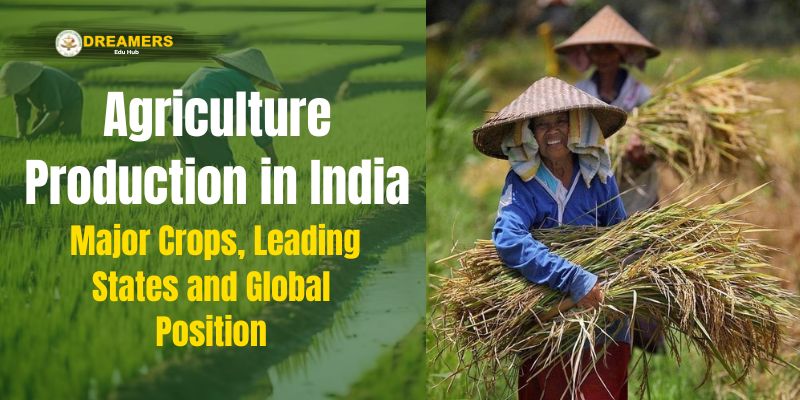Agriculture is the base of the country’s economy. A large share of the population still depends on farming and allied activities for its livelihood. Agriculture provides food grains, fodder, raw material for industries and a big market for transport, storage, machinery and fertilizers.
Even though industry and services contribute a larger share to GDP now, strong agriculture production in India remains essential for food security, price stability, rural employment and overall social balance. When agriculture performs well, demand for clothes, housing materials, vehicles and consumer goods also increases, helping the whole economy grow.
Share of Agriculture in GDP and Employment

Over the decades, the share of agriculture in GDP has gradually reduced with industrialisation and growth in services. However, the share of employment in agriculture is still high. Large numbers of rural households earn their income from fields, orchards, plantations, dairies and fisheries.
This means that even small improvements in agriculture production in India, such as higher yields or better prices, can directly improve the lives of millions. Strong agriculture also supports food-based welfare schemes and helps keep inflation under control.
Types of Cropping Seasons in India (Kharif, Rabi, Zaid)
Farming in India operates mainly through three seasons: Kharif, Rabi and Zaid.
Kharif crops are sown with the arrival of the monsoon (June–July) and harvested in autumn (September–October). Rice, maize, cotton, groundnut and jute are typical Kharif crops.
Rabi crops are sown in winter (October–November) and harvested in spring (March–April). Wheat, gram, mustard and barley are important Rabi crops.
Zaid crops grow in the short summer period between Rabi and Kharif, such as watermelon, cucumber and some fodder crops.
These seasons shape both the pattern and timing of agriculture production in India across different regions and climates.
Major Crop Groups Grown in India
Foodgrains: Cereals and Pulses
Foodgrains form the core of agriculture production in India. Cereals include rice, wheat, maize and millets like jowar, bajra and ragi. Pulses include gram, tur (arhar), urad, moong and masoor. Cereals supply bulk calories, while pulses provide essential plant-based protein.
India is among the world’s largest producers of rice and wheat, and also the largest producer and consumer of pulses. Stable foodgrain production supports the Public Distribution System, mid-day meals and other food security programmes.
Cash Crops: Sugarcane, Cotton, Jute, Oilseeds
Cash crops are grown mainly for sale rather than direct household consumption. In agriculture production in India, major cash crops include sugarcane, cotton, jute, tobacco and oilseeds such as groundnut, mustard, soybean and sunflower.
Sugarcane feeds sugar and ethanol industries, cotton supports the textile and garment sector, and jute is vital for sacks and packaging. Oilseeds are crushed to produce edible oils and oilcakes. The performance of cash crops affects exports, industrial growth and farmer incomes.
Horticulture: Fruits, Vegetables and Plantation Crops
Horticulture has become a very dynamic part of agriculture production in India. It covers fruits (mango, banana, apple, citrus, grapes), vegetables (potato, onion, tomato and many others) and plantation crops (tea, coffee, rubber, coconut, arecanut).
Horticulture contributes to better nutrition, export earnings and value addition through processing and packaging. Many farmers shift gradually from traditional cereals to fruits and vegetables because of higher returns per hectare, wherever storage and market access are available.
Other Important Crops: Spices, Medicinal and Floriculture
India is famous as a land of spices. Crops such as black pepper, cardamom, chilli, turmeric and coriander are important in both domestic and export markets. Medicinal and aromatic plants supply raw material for ayurvedic and pharmaceutical industries. Floriculture, or flower farming, supports local markets, weddings, decoration businesses and export of cut flowers. These specialised segments add diversity and strength to agriculture production in India and create opportunities beyond basic foodgrains.
Important Crops in India and Their Major Producing States

Major Cereals: Rice, Wheat, Maize, Millets
Rice and wheat dominate the foodgrain basket. Rice is mainly grown in eastern, southern and coastal states with good rainfall or irrigation, while wheat is concentrated in the irrigated northern plains. Maize and millets are important in rain-fed and semi-arid regions and serve both human food and animal feed needs.
The pattern can be seen clearly in this table:
| Cereal | Major Producing States (Main Examples) |
|---|---|
| Rice | West Bengal, Uttar Pradesh, Punjab, Andhra Pradesh, Chhattisgarh, Tamil Nadu |
| Wheat | Uttar Pradesh, Punjab, Haryana, Madhya Pradesh, Rajasthan |
| Maize | Karnataka, Andhra Pradesh, Bihar, Madhya Pradesh, Telangana |
| Millets (jowar, bajra, ragi etc.) | Rajasthan, Karnataka, Maharashtra, Telangana, Gujarat |
Pulses: Gram, Tur (Arhar), Urad, Moong, Masoor
Pulses are vital for nutritional security and soil health. They fix nitrogen in the soil and reduce dependence on chemical fertilisers. Gram (chana) is the main Rabi pulse, while tur, urad, moong and masoor are important Kharif and Rabi pulses in different regions.
| Pulse | Major Producing States (Main Examples) |
|---|---|
| Gram (chana) | Madhya Pradesh, Rajasthan, Maharashtra, Uttar Pradesh |
| Tur (arhar) | Maharashtra, Karnataka, Madhya Pradesh, Uttar Pradesh |
| Urad | Madhya Pradesh, Uttar Pradesh, Andhra Pradesh, Rajasthan |
| Moong | Rajasthan, Maharashtra, Karnataka, Andhra Pradesh |
| Masoor | Madhya Pradesh, Uttar Pradesh, Bihar, West Bengal |
Strong pulse production supports balanced agriculture production in India and helps meet protein needs in daily diets.
Oilseeds: Groundnut, Mustard, Soybean, Sunflower
Oilseeds are important for edible oils, industrial uses and animal feed. India grows several oilseed crops in different regions.
| Oilseed | Major Producing States (Main Examples) |
|---|---|
| Groundnut | Gujarat, Andhra Pradesh, Tamil Nadu, Karnataka |
| Mustard | Rajasthan, Uttar Pradesh, Haryana, Madhya Pradesh |
| Soybean | Madhya Pradesh, Maharashtra, Rajasthan |
| Sunflower | Karnataka, Andhra Pradesh, Maharashtra |
Growth in oilseed cultivation and productivity can reduce dependence on imported edible oils and strengthen the position of agriculture production in India in global markets.
Cash Crops: Sugarcane, Cotton, Jute, Tea, Coffee, Rubber
Cash crops bring income, employment and export earnings. They also support large agro-based industries.
| Cash Crop | Major Producing States (Main Examples) |
|---|---|
| Sugarcane | Uttar Pradesh, Maharashtra, Karnataka, Tamil Nadu |
| Cotton | Gujarat, Maharashtra, Telangana, Haryana, Rajasthan |
| Jute | West Bengal, Assam, Bihar, Meghalaya |
| Tea | Assam, West Bengal (Darjeeling, Dooars), Tamil Nadu, Kerala |
| Coffee | Karnataka, Kerala, Tamil Nadu |
| Rubber | Kerala, Tripura, Karnataka, Assam |
These crops show how agriculture production in India is closely linked to sugar mills, textile mills, tea estates, coffee curing works and tyre factories.
Fruits and Vegetables: Mango, Banana, Apple, Potato, Onion, Tomato
India is a major producer of many fruits and vegetables. These crops give high value per hectare and support nutrition-focused agriculture.
| Crop | Major Producing States (Main Examples) |
|---|---|
| Mango | Uttar Pradesh, Andhra Pradesh, Bihar, Maharashtra, Karnataka |
| Banana | Tamil Nadu, Maharashtra, Gujarat, Andhra Pradesh, Karnataka |
| Apple | Himachal Pradesh, Jammu & Kashmir, Uttarakhand |
| Potato | Uttar Pradesh, West Bengal, Bihar, Gujarat |
| Onion | Maharashtra, Karnataka, Gujarat, Madhya Pradesh |
| Tomato | Andhra Pradesh, Madhya Pradesh, Karnataka, Odisha, Maharashtra |
Horticulture has become a strong pillar of agriculture production in India and creates scope for processing, cold storage and exports.
Major Producing Countries of Important Crops (From Cereals to Fruits)

Top Producers of Major Cereals: Rice, Wheat, Maize, Millets
Globally, cereals are dominated by a few large producers. China and India are leading producers of rice and wheat. The United States, China and Brazil are big maize producers. India also plays an important role in millets, especially after their recognition as “nutri-cereals.”
Top Producers of Pulses and Oilseeds in the World
India is the largest producer and consumer of pulses. Canada and Australia are also important suppliers in the world market. In oilseeds, soybeans are led by Brazil, the United States and Argentina, while groundnut is produced significantly in China, India and some African countries. These patterns influence trade and price movements that affect agriculture production in India.
Top Producers of Cash Crops: Sugarcane, Cotton, Tea, Coffee, Rubber
Brazil, India and Thailand lead in sugarcane production. Cotton is mainly produced in China, India, the United States and Pakistan. Tea comes largely from China, India, Kenya and Sri Lanka. Coffee is dominated by Brazil, Vietnam and Colombia, while rubber is produced heavily in Thailand, Indonesia, Vietnam and Malaysia.
Top Producers of Major Fruits: Mango, Banana, Apple, Citrus, Grapes
In fruits, India is the leading producer of mango and a major producer of banana and several vegetables. China is a big producer of apples, citrus fruits and many other horticulture crops. Ecuador, the Philippines and some Central American countries are also important for bananas, while grapes are widely grown in Italy, France, Spain, China and the United States.
| Crop | Top Producing Countries (Examples) | India’s Position (Broad View) |
|---|---|---|
| Rice | China, India, Indonesia | 2nd largest producer |
| Wheat | China, India, Russia | 2nd largest producer |
| Maize | United States, China, Brazil | Among top 10 |
| Pulses | India, Canada, Australia | 1st in production and consumption |
| Sugarcane | Brazil, India, Thailand | 2nd largest producer |
| Cotton | China, India, United States, Pakistan | Among top 2–3 |
| Tea | China, India, Kenya, Sri Lanka | 2nd largest producer |
| Coffee | Brazil, Vietnam, Colombia | Medium producer (important but not top 3) |
| Groundnut | China, India, Nigeria | 2nd largest producer |
| Soybean | Brazil, United States, Argentina | Smaller producer, growing gradually |
| Potato | China, India, Russia | 2nd largest producer |
| Onion | China, India, Egypt | 2nd largest producer |
| Tomato | China, India, Turkey | 2nd largest producer |
| Mango | India, China, Thailand | Dominant global producer |
| Banana | India, China, Philippines, Ecuador | 1st or 2nd largest producer |
| Apple | China, United States, Poland | Minor producer compared to top countries |
| Grapes | China, Italy, United States, Spain | Moderate producer (strong domestically) |
| Spices (overall) | India, China, Bangladesh, Vietnam | 1st / dominant producer in many spices |
Regional Pattern of Agriculture Production in India
Northern Plains: Wheat, Rice and Sugarcane Belt
The fertile alluvial plains of Punjab, Haryana, western Uttar Pradesh and parts of Bihar form the main wheat and rice belt of the country. High irrigation coverage, flat land and mechanisation support intensive farming. Sugarcane fields in Uttar Pradesh further strengthen this region’s contribution to agriculture production in India.
Eastern and North-Eastern India: Rice, Jute and Tea
Eastern India, including West Bengal, Odisha, Assam and neighbouring states, is dominated by rice-based farming because of heavy rainfall and river-fed soils. West Bengal and Assam are also major producers of jute and tea. The North-Eastern hills support spices, fruits and organic farming, adding diversity to agriculture production in India.
Western India: Cotton, Groundnut and Horticulture
Western India, especially Gujarat, Maharashtra and Rajasthan, has a strong presence of cotton, groundnut and oilseeds. Many regions have also developed horticulture, including mango, banana, grapes and vegetables under irrigation. These crops support textiles, edible oil industries and fruit exports, giving agriculture production in India a strong commercial base in this region.
Southern India: Plantation Crops, Spices and Mixed Farming
Southern states like Karnataka, Tamil Nadu, Andhra Pradesh, Telangana and Kerala show a very diverse pattern. Rice is grown in coastal and delta regions, while millets and pulses dominate dry interior areas. Plantation crops such as coffee, tea, rubber, coconut and arecanut, along with spices like pepper and cardamom, flourish in the hills and coastal belts. This mix makes southern agriculture production in India rich in both food and high-value crops.
Challenges and Future of Agriculture Production in India
Issues: Small Holdings, Low Productivity and Climate Change
Despite its strengths, agriculture production in India faces several challenges. Land holdings are small and fragmented, making mechanisation and efficient irrigation difficult. Productivity of many crops is lower than world averages due to soil degradation, limited extension services and uneven access to quality seeds and inputs.
Climate change adds more pressure through irregular monsoon patterns, rising temperatures, floods and droughts. These factors increase risk and make planning harder for farmers and policymakers.
Need for Irrigation, Technology and Value Addition
Improvement in agriculture production in India requires better irrigation coverage and efficient water use. Micro-irrigation, rainwater harvesting and upgraded canal systems can save water and stabilise yields. Technology such as high-yielding and climate-resilient varieties, soil testing, precision farming and digital advisory services can raise productivity.
Value addition through cleaning, grading, processing, packaging and branding can increase income from the same crop output. Strong supply chains, cold storage and farmer-producer organisations help link farms with markets and food processing units.
Future Opportunities in Agri-Exports and Food Processing
Global demand for safe, diverse and processed food is rising steadily. With its wide range of crops and climatic zones, agriculture production in India has the potential to become a major supplier of cereals, pulses, spices, fruits, vegetables and processed products.
Forward-looking policies that support sustainable farming, encourage climate-resilient practices, promote organic and natural farming where suitable, and develop food processing clusters can unlock this potential. In such a future, agriculture production in India will continue to provide food and jobs, while also driving exports, innovation and inclusive growth across the country.
Doon Defence Dreamers on the Importance of Agriculture Production in India
For Doon Defence Dreamers (the best NDA coaching in India), agriculture production in India is not only a topic for exams, but a pillar of national strength and stability. A country that can feed its population, supply raw material to industries and support rural livelihoods through strong agriculture is far more secure from internal and external shocks. At the academy, mentors explain how wheat and rice from the northern plains, pulses and oilseeds from central and western India, and tea, coffee and spices from the hills together shape food security, trade and strategic reserves.
Cadets learn that droughts, crop failures, inflation and farmer distress can affect national morale and internal peace, while efficient farming, irrigation and storage systems support steady growth and social harmony. By linking food security, rural economy and national security, Doon Defence Dreamers helps aspirants understand that agriculture production in India is deeply connected to the overall strength and readiness of the nation.
Frequently Asked Questions (FAQs)?
Q.1. Why is agriculture production in India still important when industry and services are growing?
Agriculture production in India continues to matter because a large part of the population still depends on farming for income and employment. It supplies food grains, pulses, fruits, vegetables and raw materials to industries like textiles, sugar, food processing and beverages. Strong agriculture also supports food security, controls inflation and helps maintain overall social and economic stability in rural areas.
Q.2. Which are the major crop groups that shape agriculture production in India?
The main crop groups are cereals and pulses (foodgrains), cash crops (sugarcane, cotton, jute, oilseeds), horticulture (fruits, vegetables and plantation crops) and specialised crops like spices and medicinal plants. Cereals and pulses form the base of food security, while cash crops and horticulture create income, export potential and value addition. Together they give agriculture production in India a balanced mix of food, fibre, fuel and industrial raw material.
Q.3. How does India rank globally in the production of important crops like rice, wheat, sugarcane and mango?
India is among the leading producers of many important crops. It is the 2nd largest producer of rice and wheat, and also the 2nd largest producer of sugarcane after Brazil. In pulses, India is both the largest producer and consumer, and in crops like mango and often banana it holds a dominant or top position. These rankings show that agriculture production in India is a major contributor to global food supply.
Q.4. What are the main challenges faced by agriculture production in India today?
The key challenges include small and fragmented landholdings, low productivity in many crops, and high dependence on monsoon rainfall. Soil degradation, limited access to quality seeds, credit and markets, and the growing impact of climate change through droughts, floods and irregular rainfall make farming risky. Inadequate storage, transport and processing infrastructure also lead to post-harvest losses, which reduce the full benefit of agriculture production in India.
Q.5. Why does Doon Defence Dreamers focus on agriculture production in India for defence aspirants?
Doon Defence Dreamers treats agriculture production in India as a core part of national power because it influences food security, rural stability and economic resilience. Officers in the armed forces need to understand how droughts, crop failures, inflation and farmer distress can affect internal peace and national morale. By explaining how different regions and crops support food supply, industry and strategic reserves, the academy helps aspirants see agriculture not just as a textbook topic, but as an important factor in overall national security and governance.






























